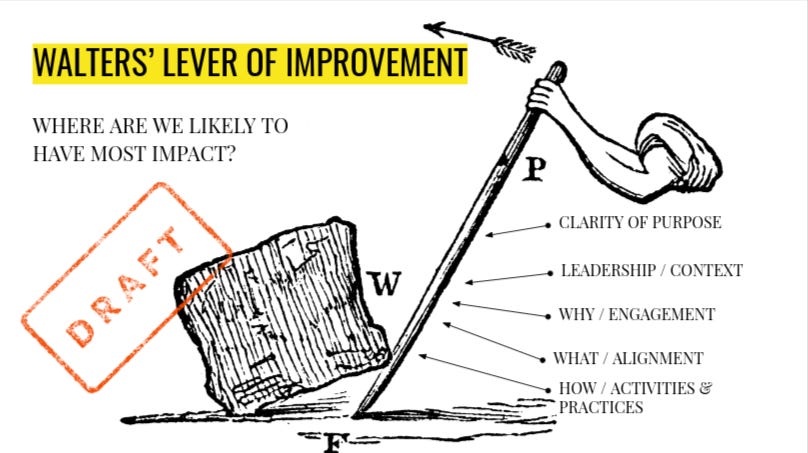Sometimes, the areas I target to exert my effort as a leader takes people by surprise. I like to make things explicit, so I prepared this simple slide.
Items higher up the lever have more leverage. I say this with the caveat that it’s assuming “on average” - of course, every organisation’s context is different. But for it not to be true at a given organisation, leaders would need to be doing these higher leverage items well already. And let’s be honest, that’s a very short list of organisations.
Let’s work through the list from the bottom (least leverage) to the top (most leverage):
Where most organisations placed an inordinate amount of their attention. What are the tasks and projects? What are the programmes? How are we doing this work? Who is responsible? What skills are involved? This stuff is important and doesn’t go away but as we move up the lever and exert effort with other points of leverage we may find more of these details are engaged throughout the organisation and may share the limelight with other contextual information.
This could be communicating the key projects/programmes, pillars of activity, or announcing practices being embraced. This can provide some alignment but also can present barriers to understanding because naturally, people in different parts of an organisation have different degrees of understanding and connection to the work being done.
Communicating the outcomes and measures of progress towards achieving the desired effects for the organisation or its customers is a powerful approach to alignment. When people know what they are collectively trying to achieve they can determine the how themselves (or at least course correct the how because they know what success is supposed to be).
This might be by communicating the OKRs or other forms of communicating outcome-oriented goals. Communicating about goals can be more effective for alignment because it requires knowledge of the purpose of the organisation and how it operates within the market, something there can be a broader understanding of across the organisation.
Whilst there can be strong alignment when including the what in communication it’s still possible for misalignment to occur when the logic behind the goals is not well understood. Why is this our strategy? Why do we think this will help us win against the competition? Why are these the jobs to be done we are addressing for our customers?
This might be in the form of an explanation, prose, diagrams or, as I have had success with, causal chains, network maps, result maps, mind maps or other types of relationship diagrams.
All of the above are examples of leadership communication and communication of context but not it’s not an exhaustive list. So I put this in as a further catch-all. There’s judgement to be applied as leaders on what additional context we can provide teams that is useful. There’s help with situational awareness, there’s the communication of events that may affect morale or decisions team members will make.
These are things that are addressed in regular cadences. By having good sources of information flowing in and by actively thinking about what will be useful to be communicated. It’s amazing how often you find people struggling in organisations simply due to information they are lacking which is sitting with their leaders.
It’s one thing to be engaged. Its another to be activated by an organisation’s mission or purpose. There seems to have been a movement which led to organisations investing in vision, purpose and mission statements but then, for some reason, stopping there.
Can we find more connections to these high-level thoughts? Can we link it to what we are trying to achieve? Can we use it to explain why we chose one strategic option over another? Do people know the purpose of all parts of the organisation? Purpose is not a paragraph, it’s a tapestry. Leaders have a role to weave it and to show others how to join in.
What do you think of this model? Do you agree that effort in these areas, can, over time, help achieve more impact? Are there some concepts I have higher on the lever that you are sceptical can have a greater level of impact than items lower down? Chime in, in the comments.
from Hacker News https://ift.tt/qrJYe5i

No comments:
Post a Comment
Note: Only a member of this blog may post a comment.